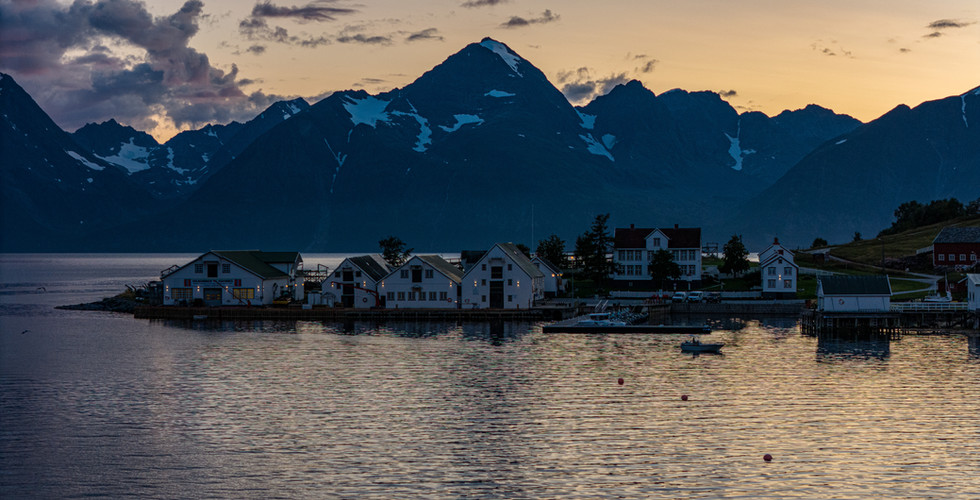See the Northern Lights with the best views of the Lyngen Alps — stay in Havnnes, a short journey from Tromsø
- Havnnes Handelssted

- Sep 29
- 3 min read

Havnnes Trading Post is Northern Norway’s best-kept secret for authentic stays near Tromsø. It’s a listed, working 19th-century trading post where WWII destruction spared the buildings, leaving a living community of white wooden houses facing the Lyngen Alps.
Why Havnnes ranks for “accommodation in Tromsø & Lyngen”
Close to Tromsø, perfect base: About 3 hours from Tromsø to the Rotsund ferry, then a short ferry hop to Havnnes on Uløya. Buses also run from Tromsø to the ferry, as well as the Arctic Route bus, which also serves this stretch.
Low light pollution: Ideal Northern Lights conditions with sweeping fjord and Lyngen Alps vistas.
Cultural cachet: Awarded the St. Olav’s Rose for outstanding cultural experiences, a rare mark of quality.
Easy access: The Rotsund–Havnnes–Uløybukt ferry is short and straightforward; some departures are on demand.
Sleep inside living heritage
Havnnes is Norway’s northernmost trading post still in operation. The general store and preserved waterfront tell 200+ years of Arctic trade and stockfish stories — and you can stay right among them.
Highlights
Historic houses with modern comfort (sauna/jacuzzi options)
Fjord-front views of the Lyngen Alps
Intimate atmosphere (about 20 full-time residents)
Tip: Browse our houses, including Banken, Messa, Waagen, Per Arne, and other unique options to find one that matches your style and group size.
Northern Lights, whales, skiing — all from one base
Aurora season (Sep–Mar): Watch the lights right from your porch, pier, sauna or jacuzzi.
Whale watching (winter): Fjords near Uløya host orca and humpback activity in season.
Dog sledging & Sami culture: Day trips across the Lyngenfjord region.
Backcountry skiing: Uløya and Lyngen offer renowned ski-touring terrain from beginner-friendly routes to big mountain lines.
Summer & autumn: Midnight sun hikes, kayaking and quiet beaches with panoramic alpine backdrops.

Getting to Havnnes from Tromsø
Drive or bus to Rotsund (E6): ~3 hours from Tromsø; multiple daily buses.
Ferry Rotsund → Havnnes: Short crossing; check timetable (some sailings by request).
Practical note: The ferry line is simple and commonly used by visitors; verify current times before travel. The ferry is free to use.
Plan your stay
Best months for Northern Lights: late Sep–Mar
Best months for midnight sun: late May–mid-July
Stay length: 3–5 nights gives flexibility for aurora weather windows
Ideal for: couples, families, photographers, ski tourers, heritage lovers
Book authentic accommodation in Havnnes
Tell us what you want to experience (aurora, whales, skiing, sauna/jacuzzi, museum & shop), and we’ll tailor your stay and organise partner-priced activities across Lyngenfjord.

FAQs
Is Havnnes a good alternative to staying in Tromsø for the Northern Lights?
Yes. Havnnes combines low light pollution with open fjord views and a Lyngen Alps backdrop — making it an excellent spot for aurora watching, while still being reachable from Tromsø.
How do I get from Tromsø airport to Havnnes without a car?
Take the bus from Tromsø Prostneset to Rotsund Kai (approximately 3 hours), then take the short ferry (about 10 minutes) to Havnnes. You can also take the Arctic Route, more info on their website.
What makes Havnnes “authentic”?
It’s a working, listed 19th-century trading post — not a theme village — with award-recognised cultural value and preserved buildings spared by WWII’s scorched-earth retreat.










































































































Comments